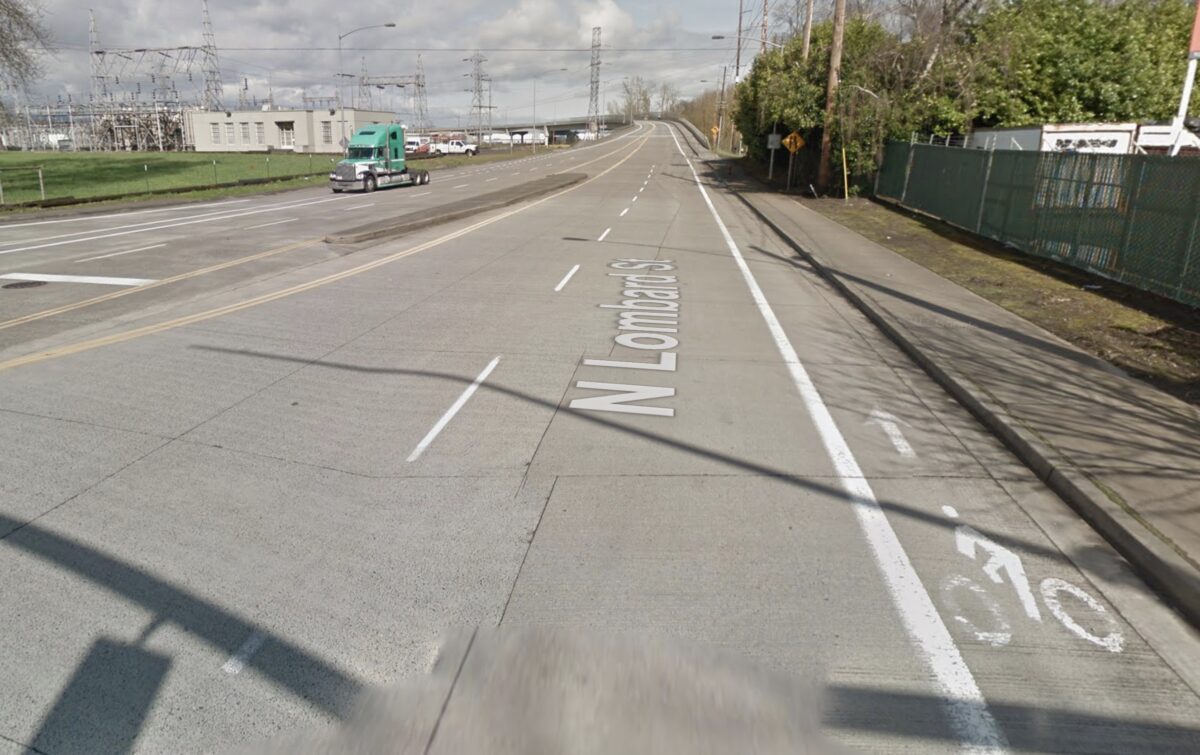
When it comes to bike network quality, gaps are a killer. All it takes is one bad intersection and every investment we’ve made on either side of the gap won’t reach its potential.

This is the situation in the Rivergate Industrial District on the peninsula north of downtown St. Johns. The unsafe intersections are on either side of the railroad overpass on North Lombard between N Burgard and Rivergate Blvd. These are major industrial areas with wide intersections where intimidating freight trucks are driven at speeds 45 mph and above. There are bike lanes, but they don’t meet current city standards and are usually strewn with gravel, glass and other driving-related detritus.
One each side of these intersection are areas of relative peace. To the north is where the popular multi-use path to many jobs, and major recreation sites (Kelley Point Park and Smith & Bybee Lakes) starts and where the Portland Bureau of Transportation recently finished a multi-million dollar bridge project with a new, grade-separated bikeway on North Rivergate Blvd. And to the south is where PBOT installed a protected bikeway in 2018 that connects to Willamette Blvd.
When the Parks Bureau completes the carfree bridge over Columbia to connect Chimney Park to the 40-Mile Loop path, it will become even more important to protect the growing number of bicycle users at these intersections.
Thankfully, PBOT has set their sights on this gap and plans to make changes by summer.
Advertisement
In order to create safer space for cycling on both ends of this overpass, PBOT plans to reconfigure lanes, add a buffer to the northbound bike lane, and route southbound bicycle riders onto an existing sidewalk. A presentation by City Bicycle Coordinator Roger Geller at the Portland Freight Advisory Committee meeting on April 7th outlined the problem and proposed solution.
PBOT’s plan would actually reduce the overall cycling space, but it would also reduce conflict points, Geller says. At the freight committee meeting he detailed 10 conflict points for bicycle riders spread between the two intersections.
The overpass currently has five-and-a-half foot bike lanes on each side of Lombard. PBOT wants to create a wider bike lane on the north side that would be nine feet wide (six feet for cycling and a three foot buffer). The biking space would get even wider at the Columbia/Burgard/Lombard “t” intersection when riders leave the existing sidewalk and come back to the street level. A new bicycle traffic signal would then get riders across the intersection and onto the existing protected bike lane on Burgard (which turns into Lombard to the north and south). The additional width for the bike-only lane at this intersection would result in one less general purpose lane.
Advertisement
Knowing that the freight committee is often resistant to lane width reductions and trucking capacity, PBOT conducted a traffic study in March 2020 to understand potential impacts of this project. The conclusion of Portland City Traffic Engineer Andrew Sullivan was that, “…this intersection currently operates so far under capacity that the loss of the traffic lanes … is inconsequential to traffic throughput.”
Truck drivers won’t have as many lanes to use, but the plan widens the southbound lane from 12 to 14 feet.
Since bicycle riders wouldn’t have to cross Lombard as many times, PBOT figures even with an overall reduction in bike lane width, the project will reduce 10 major conflict points to just three minor ones (where driveways to industrial businesses cross the bikeway).
At the urging of freight committee members, PBOT plans to test the new lane configuration on a trial basis over the next two months and, barring any issues, will install the new design this summer. One aspect of the project we aren’t yet clear on is whether the bike lane buffer zone will come with any protective materials such as curbs or bollards.
Stay tuned.


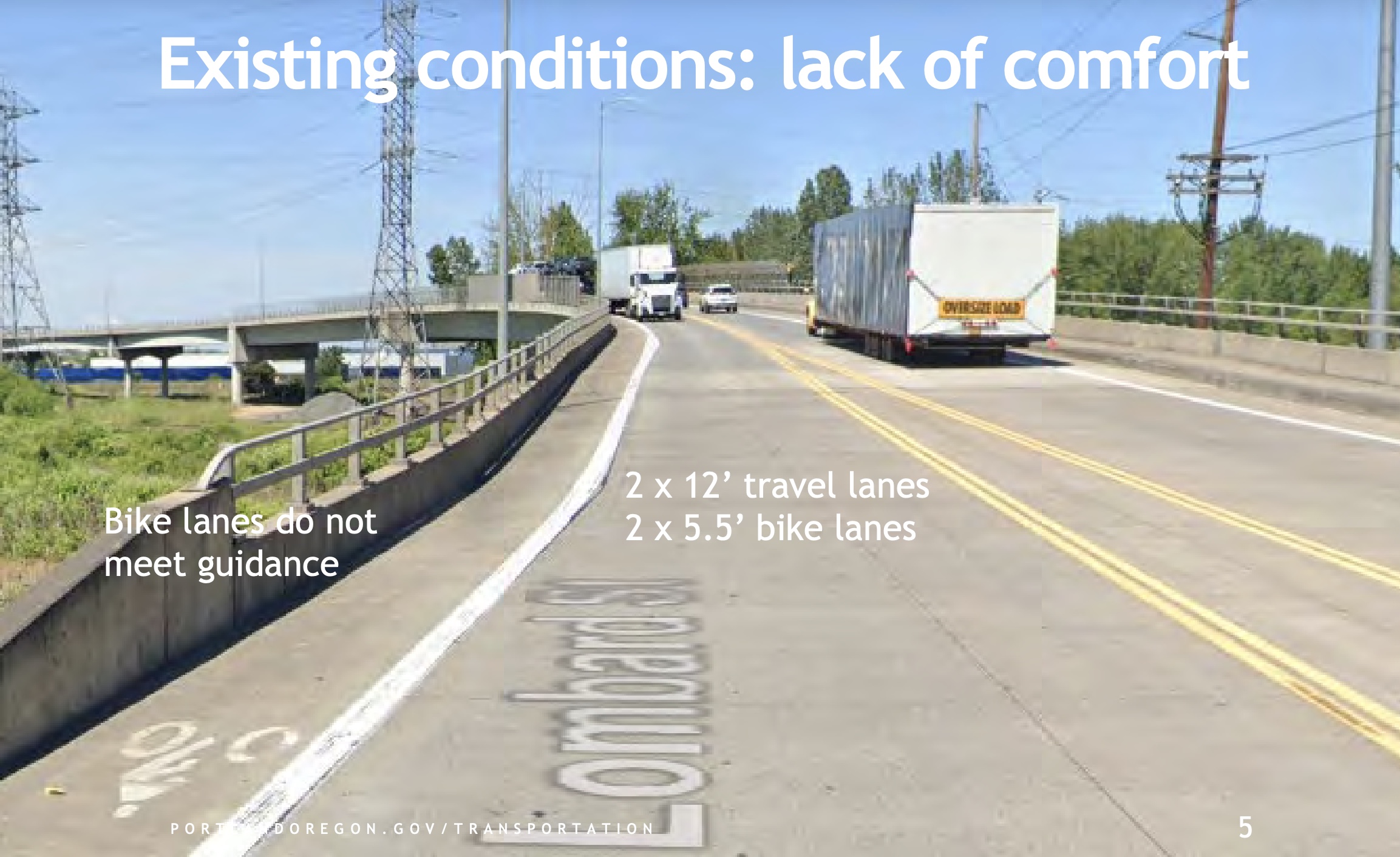



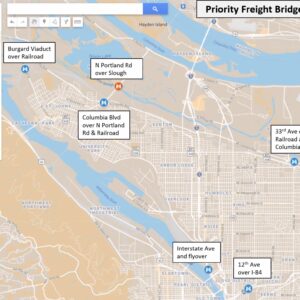

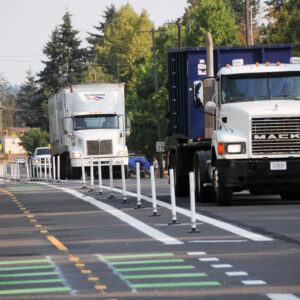
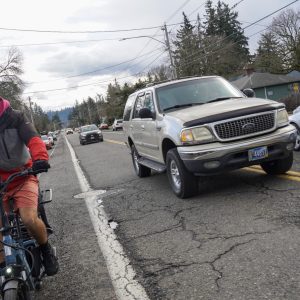
Thanks for reading.
BikePortland has served this community with independent community journalism since 2005. We rely on subscriptions from readers like you to survive. Your financial support is vital in keeping this valuable resource alive and well.
Please subscribe today to strengthen and expand our work.
PBOT should raise the 6′ bike lane to match the sidewalk. Having a 6″ drop greatly reduces the useable space, bikes can’t pass or ride side by side. Plus, being at sidewalk grade would help keep the bike lanes more clear of debris. Also, the buffer should be taller than the bake lane to keep the debris from accumulating in the bike lane. Overall this plan seems like typical PBOT: spend as little money as possible to keep bikes out of the way of freight. All of the inconvenience is borne by the cyclists despite the speeding and large size of the vehicles being the root of the problem. I wish they would address getting on to those lanes coming from St Johns- the current design has bikes popping across a slip lane at the bottom of a hill- positively terrifying! FWIW, I have been detouring down Time Oil Road and using the new Rivergate overcrossing to avoid this messed up intersection.
Wow, maxD – I travel there infrequently, but what a great bypass plan. I mapped it as I understand it: https://ridewithgps.com/routes/39051660 – I come from Vancouver, so this would be my route. How’s the traffic on your detour?
The traffic on weekends is great- nearly empty. During business hours, there are quite a few trucks.
Excellent. We’ll be through there about 10am Sunday – should be no problem no matter what way we go, but I’m trying yours! Thank you!
If PBOT took your suggestion, instead of getting built this summer it probably wouldn’t get built until that bridge is replaced…in how many decades? You can’t just throw a ton of new concrete on a bridge that wasn’t designed for it without (probably) millions and millions of dollars.
As somebody who lives in St. Johns, this is very exciting news. It will be a huge improvement and make it much less stressful biking up to Kelley Point Park.
John, there is not reason this would take any longer to build. I would be surprised if the bridge could not support a iteratively small static load spread over the length of the entire bridge. There are lightweight structural foam options that be used as a base, or have no base and used pultruded fiberglass decking. Providing a meaningful, successful design for cycling should not take any significant additional time, just a bit more commitment and relatively small increase in cost. PBOT appears to be 100% committed to spending the absoute least amount of money to shunt bikes out of the way of freight (see Greeley)
It’s possible that you don’t have a very good understanding of structural engineering or how concrete works. You can’t just pour it right on top of the existing roadway, it needs a way to adhere to the base. How should that be done? One way is with metal dowels pounded into the ground. Would the bridge deck be damaged doing this? Should PBOT just give it a try and hope for the best? Typically these things need engineering, which equals time, which equals money. We’re not talking a “relatively small increase in cost.” We’re talking big dollar sign money.
I also like Greeley though, a lot more than what was there before. Maybe we’re just different kinds of people.
very patronizing, you don’t know me.
No thank you for the mansplaining. I am not a structural engineer, but I am a consultant and work closely with Structural, Civil and Geotechnical Engineers on projects for ODOT, PBOT, BES, PWB, PP&R, Metro and other local agencies. I am familiar with retrofits, what is possible and ballpark costs.
Totally true. This a freight project being dressed up as a bike project, just like the N Greeley highway expansion.
This whole area needs traffic calming. I don’t bike back here despite it being extremely close due to both the heavy freight and the motorists who like to go 60 – 70 MPH down these streets.
My spidey sense says plastic bollards that will be destroyed in three months. I doubt PBOT is going to actually spend any real money on safety infrastructure.
Especially with all of the street racing and drunk driving in this area, those plastic wands aren’t going to last long.
The existing bike lane is frequently covered in gravel and debris from the trucks since it is rarely cleaned. If the proposed buffered lanes have a curb or bollards, my concern is that debris will be even worse and it will be more difficult for riders to avoid it.
Yep, Geoff – the wand- and curb-protected lanes all over the city are covered in gravel and other debris 95% of the time. It’s a real problem and PBOT needs to get a handle on it.
My theory is that DOTs know only how to build stuff – they do NOT care about maintaining a facility once it’s built. They don’t want to do this hard, unsexy work.
I rode this route yesterday and it was still covered in gravel and sand from the snow in December as well as shards of metal. The protected bike lanes on Lombard in St. Johns were a total mess as well. If the city can’t maintain the infrastructure we have, what’s the point in building new “protected” infrastructure?
Love this project. I ride this route with my little one on back to get out to Kelly Point from St Johns. This overcrossing is the only challenge on an otherwise pleasant ride. We’ve been riding the sidewalk because of the proximity to large trucks, but I think a buffered bike lane will be comfortable enough for our needs. Obviously it isn’t the perfect solution, but it works.
What’s the point of this? Is it really true that freight interests will say “well, we get one less lane, but the lane we get is huge!” Why not take the extra 2 feet and put it in the safety buffer?